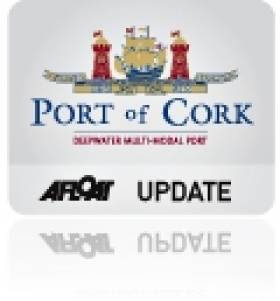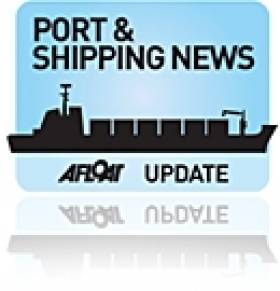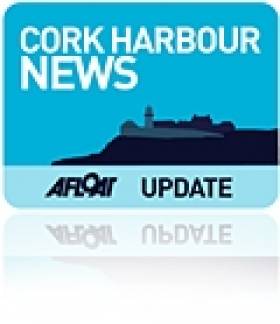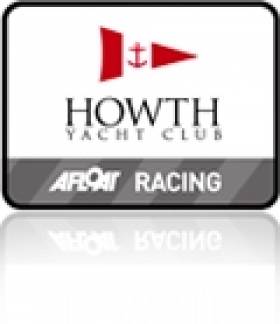Displaying items by tag: Cork Harbour
Seaplane Service Makes Cork Harbour Test Flight
Port of Cork Opens its Doors for Heritage Day
On Saturday 28th August 2010, the Port of Cork will open its doors to the public from 11am until 4pm as part of Cork Heritage Day. The spectacular rooms of Custom House will be open to the public offering visitors the opportunity to view the impressive boardroom and committee room as well as the fine collection of maritime artwork owned by the Port of Cork Company.
With the new Port of Cork City Marina in place, the Port of Cork is encouraging boat owners to use the facility for Cork Heritage Day.
Commercial Manager Michael McCarthy said; 'The Pork of Cork are delighted to open Custom House once again to the public and what better way to arrive in the city than by water. We are encouraging all boat owners if they are planning on visiting the city for Heritage Day to use the Port of Cork City Marina, which allows excellent access to all the city attractions.'
The Port of Cork City Marina is free to use during the day, however overnight charges do apply. It is advisable to pre-book a berth if planning on visiting the city by boat for Cork Heritage Day. To request a berth please visit www.portofcork.ie
Irish Shipping Trade Volumes Return to Growth
The midyear data in particular points towards trade volume growth in three of the principal freight segments; most significantly in lift-on/ lift-off (lo/lo) export trades which we estimate grew by 5%. Roll-on/Roll-off export traffic was also up 5% per cent on an all island basis. Dry bulk volumes through ROI ports increased by 15% for the first six months compared to the same period last year. Shipments in April this year saw the strongest monthly volume of bulk cargoes in over 2 years.
Roll-on/roll-off (ro/ro) traffic on an all-Island basis continued to make a steady recovery with an increase of 2%, up to 771,585units for the first half of 2010. The ro/ro segment is largely weighted towards services to and from the UK which remains our largest trading partner.
The most significant change in volume has been in the main lo/lo trades. Overall total volume including export and imports fell only marginally by 1% to June with 517,552 units being handled. However this compares to a -24% reduction for the same periods last year.
A key factor in the positive upward movement has been the continued strong performance of export volumes which as noted was up 5% year on year. Import volumes were down 2% which is largely as a result of continued weak domestic demand. Nonetheless the rate of decline in import volumes has eased sharply which is possibly also offset by demand for industrial imports used as inputs for the merchandise export trades.
The sharp fall in import units over the last 24 months has inversely created a problem for export companies as there is now reduced supply of export quality containers available in Ireland. As a result shipping lines have to reposition empty containers from the UK and Continent which in turn adds to the overall cost of the export box.
Dry bulk (Bulk carrier) trades recovered some of the record volume losses seen in 2009 with a strong 15% increase between January and June. Part of this recovery is attributed to stronger domestic demand for grains, fertilizers and other agricultural products, while improved global demand for steel and other ore aggregates also pushed up volume throughput.
Breakbulk volumes through ROI ports linked to construction inventories such as steel and timber continued to decline by 11%, which is half the recorded figure for 2009. Nonetheless volume activity in this segment remains at a historically low level.
Liquid bulk (Tanker) volumes such as oil fell by 4%, with lower transshipment storage for the US market and other seasonal factors impacting on demand. The outlook for continued short term volume recovery remains largely contingent on the external recovery in the global economy.
Students Take to the High Seas
Imagine being able to plan, design and carry out your own scientific survey into the seas around us. Last week research students from across Europe were given just such an opportunity when they joined scientists onboard the Irish national research vessel RV Celtic Voyager in waters off Cork.
This unique opportunity for students to gain practical experience in carrying out multidisciplinary marine scientific research is part of the European Framework 7 project EUROFLEETS, and was designed, developed and co-funded by the Marine Institute, Ireland.
Over the course of six days, between the 14th and 19th August, 20 European postgraduate students learned the skills necessary to map the seabed, identify the animals and plants living there, and investigate the local and oceanic currents that influence them. Training focused specifically on operational research and included the deployment of equipment and instrumentation, sample recovery and processing, and data acquisition. Other modules investigated designing and planning a survey, operations and capabilities of research vessels and safety at sea.
Event to Showcase Cork Harbour
Cork Harbour Open Day will take place on Saturday 4th September 2010 and already there are a number of free events planned to take place around the harbour.
To name but a few, Cork City will host the World Rescue Challenge on the Port of Cork's North Custom House Quay, Cobh will host the start of the annual Cobh to Blackrock Sailing race, while in Crosshaven there will be farmers markets, rowing championships and the RNLI Station will be open to the public.
It is expected that many more events will be announced in the coming days. For a full programme please visit www.corkharbour.ie
Aimed at embracing what Cork Harbour has to offer, the Cork Harbour Open Day aims to raise awareness of the different activities available for people in the harbour both on and off the water.
The idea for a Harbour Open Day emerged from discussions between various stakeholders involved in the development and implementation of the Integrated Strategy for the Harbour. A group comprising representatives from UCC, City and County Councils and the Port of Cork set about working together to engage users of the Harbour and to organise the Open Day.
Cork Harbour is the second largest natural harbour in the world, next to Sydney Harbour, offering beautiful locations for enjoying the outdoors, dramatic coastlines, and excellent leisure facilities.
To get involved in Cork Harbour Open Day or to organise an event on the day, please visit www.corkharbour.ie or contact Sara Dymond at [email protected] or 021-4625375.
Irish Teams Third and Fifth in New York
After 3 very intense days of international competition at the Dennis Connor International Yacht Club Challenge, the Irish teams consisting of Royal Cork Yacht Club finished 3rd, Howth Yacht club finished 5th overall beating some very talented opposition including the two local Manhattan Yacht Club teams.
The event was sailed in a fleet of J24's and the RCYC boat was skippered by Stefan Hyde and the Howth Boat by Emma McDonald.
In fact if it was not for a penalty after a collision in race 4 (Under Regatta rules, if a collision occurs, both boats have to do turns no matter who is in the right / wrong) and the cancellation of race 7 on the last beat due to a approaching thunderstorm - podium positions for both teams could have beckoned.
The regatta was sailed in the very busy waters of the Hudson river in New York City which along with the challenges of avoiding commercial traffic, some of the strongest currents that the crew have ever experienced had to be negotiated in varied winds from 5knts on the opening day to 30knts plus during approaching thunderstorms on the final day. The 3rd Irish team; Wexford Harbour Yacht and Tennis Club finished in 10th place.
The event was won by the team from Switzerland - Societe Nautique Rolloise followed one point behind by USA - Southern Yacht Club and then a fantastic 3rd place by the Irish team from Royal Cork skippered by Stefan Hyde.
It is tradition on presentation night that each team presents to the team that finishes behind them in the final results a humourous prize.
4th place Austrian team presented the HYC team with "Lederhosen".
Howth Yacht Club also presented Commodore Michael Fortenbaugh of Manhattan Sailing Club and Dennis Connor (Americas Cup Hero) with HYC Burgees.
A fantastic event in a wonderful city that certainly promoted international goodwill through friendly competition.
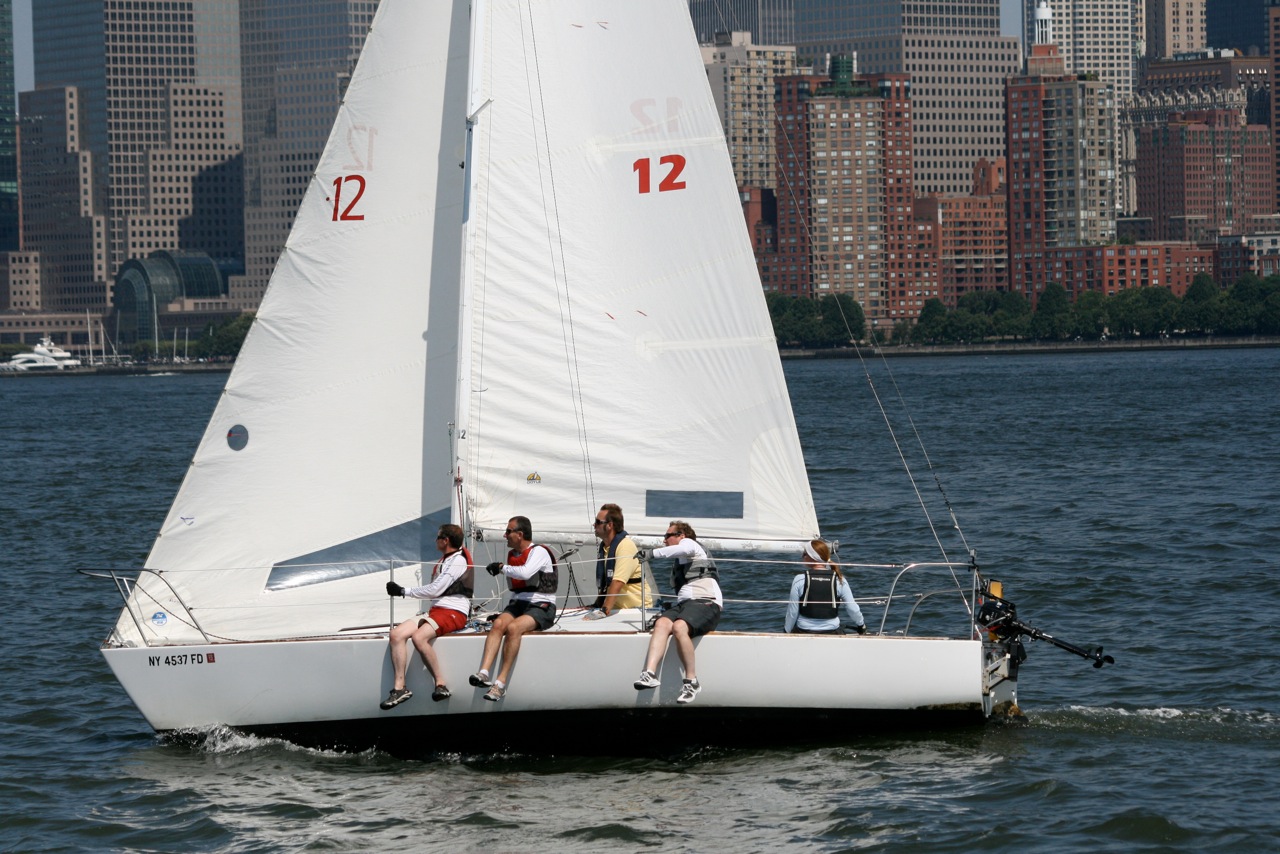



McCann Wins Opti Nationals in Consistent Style
Royal Cork Optimist ace Peter McCann completed a clean sweep of the National Championships at Waterford Harbour SC yesterday counting nine of 11 results in the top three of the combined fleet of 249 boats. McCann's consistent performance put him 11 points clear of his second placed Partrick Crosbie alos of the Royal Cork. Third was UK visitor Aarron Holman. McCann is Ireland's top-ranked Optimist sailor and in July asserted himself at the front of an international fleet , posting a first and fourth to be in seventh position overall in the 144-boat boys fleet at the Optimist Europeans.
Optimist Irish National Championships Results HERE.
Ireland Claims Victory in Blustery Rolex Commodores' Cup Finale
Ireland has done it. After mounting multiple teams, considered favourite going into both the 2006 and 2008 events but failing to win either, so the Irish boats Antix, marinerscove.ie and Roxy 6 today secured the Rolex Commodores' Cup for the emerald isle.
"It is delightful to finally have a chance to get our hands on the trophy," declared Anthony O'Leary, owner and helmsman of the Ker 39 Antix, the Irish team's big boat. "For all three boats, the Rolex Commodores' Cup has been the absolute pinnacle of what we have wanted to do this year. While Antix and marinerscove have been around, it is a credit to the guys on Roxy because they had a new build and got the boat in the water, and then there were all the attendant things you have to do. Owner Rob Davies, in fairness to him, didn't take a huge amount of persuasion to sign up and make the extra effort required to do it. We owe him a huge debt."
winn
Roxy 6's pro sailor Maurice 'Prof' O'Connell added: "We put in a massive effort and it is nice to have got the reward. Cowes is going to go ballistic tonight!"
The 2010 Rolex Commodores' Cup could not have finished on a better note. While the day dawned grim, with rain and visibility down to less than a mile, by start time at 10:30BST it was blowing 20+ knots and with the tidal effect this was churning up the Solent. With the weather mark not visible there was a distinct Irish hiccup on the first start when Antix collided with a French competitor and had to carry out a penalty turn.
"It was 110% our fault, but we are glad we got it out of the way," said O'Leary. "Fortunately with that amount of weather, there was always going to be a chance to have a come back."
And so it was on the run when, with the wind gusting to more than 30 knots and the sea seeming to come from all directions, that there were many instances of boats becoming overpowered and wiping out. This provided O'Leary and his crew with the chance they were looking for: "Down the first run Inis Mor tried to gybe, spun out and blew her kite to bits. White Heat had the same problem just ahead. Then we got to the bottom mark and our friends from Hong Kong trawled the kite, so we got inside them. Then we extended to the finish."
This was enough for Antix, despite her poor start, to post a second, typical of her scoreline this week, which has never featured a result lower than this.
One of the most dramatic scenes from the water today was of the Farr 45 Alice II in GBR White, streaming the top of her blown out spinnaker on the final upwind leg at the extent of the halyard.
"Coming into the leeward mark we saw 36.4 knots," recounted Alice II crewman James Read. "We were doing 17 knots in flat water and about one third of the chute was in the hatch and then thehead just caught the water and then 'zooop' it went out of the back, the sheets, the lot... We tried to blow the halyard but it wrapped up. So we flew it as a massive flag for the last beat! It was a bit of an air break."
In the two smaller classes, there were few boats that came off unscathed, other than the impeccable Irish. Peter Rutter's Grand Soleil 43 Quokka 8 in GBR Red had to retire when the bottom of their mast buckled. On the downwind legs there were many many broaches, the most dramatic being that of François Blossier's A-35 RealAx in France Red, which ended up with her masthead almost in the water.
"It was a little bit windy," admitted Blossier, who sails with a completely amateur crew and raced the Rolex Commodores's Cup four years ago on Pierre Follenfant's TBS. "We had a problem, because we took the big black spinnaker and we probably should have taken the smaller one. When we gybed we had a little bit of trouble with the pole...and that was it."
On board Blondie IV with the Hong Kong teams, Jamie McWilliam found the conditions exhilarating. "It was a perfect day, brilliant. I wish it had been like that all way. The funny thing about it, it was very tricky to catch a set of waves that worked because they were coming from everywhere. It was very sporty coming down the last run. The tack shackle of our tack line on the kite, which has a working load of 4 tonnes, exploded in a 20 ton gust. It was magic!"
McWilliam's Hong Kong team finished second to the Irish, on 117.5 points to Ireland's 73.5. However McWilliam was satisfied with the result: "I think if we'd been second having cocked it up, it would have been irritating, but the Irish guys sailed with great style and great skill and I'm absolutely delighted for them."
Andrew McIrvine, Commodore of the RORC said that his Beneteau First 40 La Réponse had been pushed to the limit. "We shredded a spinnaker. All our jammers started slipping. We have never put them under so much load before - they were tested beyond their working strain."
Otherwise McIrvine was pleased with the outcome of the regatta. "It has gone very well, particularly for the Irish who very much deserved their win. It was a very exciting day. As the French said it was 'un peu agitée'!' The results are good. Everyone had a good day. Ireland deserved it. They got so nearly there before. Now they have a hot team and they have gone for it properly and they deserved to win."
Top Five Teams – Provisional Overall Positions after completion of 8 races
Team / Points / Place
Ireland / 73,5 / 1
Hong Kong / 117,5 / 2
France Blue / 136 / 3
France Yellow / 167 / 4
GBR red /175 / 5
Full results and team lists are available at http://commodorescup.rorc.org/
Additional PR issued by ICRA;
Ireland wins Rolex Commodores' Cup at Cowes
As winds gusted to Near Gale force, Ireland's three boats in the Rolex Commodores' Cup delivered their strongest result since last Sunday's first day with a first and two second places in the high-scoring series finale. The Irish Cruiser Racing Association team of Antix, marinerscove.ie and Roxy will be presented with the trophy at the Royal Yacht Squadron at 5.00pm today.
Mist and driving rain clouded the racing area for the duration of the 90-minute race but presented no obstacles to the trio. Team captain Anthony O'Leary at the helm of Antix was able to recover from a pre-start incident with a French entry by taking a penalty-turn seconds before the start to avoid a protest and went on to score second place in Class 1.
Both marinerscove.ie skippered by Dave Dwyer and Roxy 6 subsequently steered clear of other boats and started well to score a race win and second place respectively. Overall, Ireland increased its lead to a winning margin of 44-points with Hong Kong placed second and France Blue in third.
"We finally managed to do what we've been trying to do for quite a very long time," commented O'Leary at Cowes Yachthaven marina shortly after coming ashore. "Thankfully we got the conditions that suited the Irish boats better than others; we are strong in those winds as we're well used to sailing them at home."
The win is the first major international trophy at Cowes in almost four decades of successive Irish teams who have come close to overall wins in the Admiral's Cup in 1979 and 1987 also as more recently in the Rolex Commodores' Cup that succeeded it.
"If you go back 30-odd years, you had Denis Doyle, Clayton Love and Archie O'Leary bringing boats here to sail in the Admiral's Cup," said O'Leary. "The demise of the Admiral's Cup led to the start of this event and Ireland has been sending teams for a very long time.
"We've been winning races and in the hunt in both previous events but seemed to fall at the final hurdle or not have that vital bit of luck when it counted. This time round I think probably we've had the strongest team we've ever had, with good focus and it managed to work out well."
The three-boat team was supported by shore-crew and representatives from the Irish Cruiser Racing Association both in Cowes and with extensive assistance from home as well. "This is the result that we had set our sights on and through the dedicated and united effort of everyone, we have won the Commodores' Cup for Ireland and Irish Sailing," said Barry Rose, ICRA Commodore. "We look forward to bringing everyone together at home for a full celebration of our sailors' achievements in Cowes over the past seven days."
"The fact that there are 50-plus people here for a week, trying to win a sailing event is proof enough that we want it and we were prepared to work very, very hard to get there and thankfully it came off in the end," said O'Leary.
Privatisation of the Ports Should be Strongly Opposed
In the first installment of a new weekly maritime blog on Afloat.ie, marine correspondent Tom MacSweeney says our ports are vital national assets;
It astonishes me that the Government should consider selling off the country’s ten major port companies - Dublin, Cork, Dun Laoghaire, Waterford, Shannon/Foynes, Drogheda, Galway, Wicklow, New Ross and Dundalk.
Ninety-five per cent of Irish exports and imports go by sea through our ports which are the vital entry and exit points of our transport system. To consider privatising them is an example of how unaware the Government is that Ireland is a small island community on the periphery of Europe.
The lesson of transport chaos caused by the Icelandic ash grounding aircraft this year has not been learned. It demonstrated how vital maritime transport is to this island nation.
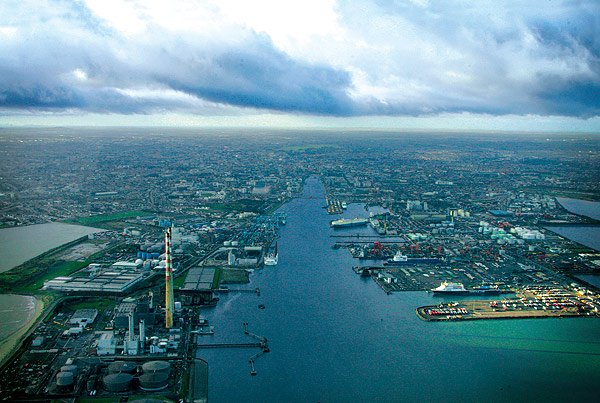
Dublin Port Company - a profitable state company
This is a smash-and-grab raid, redolent of a bankrupt Government philosophy. It is one thing to consider selling off the family jewels when, at least, the householder would still have access to the house. To sell off the ports is akin to the householder selling off the driveway, porch and front door to the house, then having to pay for the right to use them to enter the house in the future.
The Government has failed to develop a national ports policy. In the Progressive Democrat-fuelled era when privatisation, competition and profits were its driving force, the ports were moved out of direct State ownership and turned into semi-State competing bodies. Iarnrod Eireann was permitted to largely opt out of rail freight operations through the ports. Turned loose to compete against each other, the port companies followed no overall national policy for the benefit of the nation and now their future has been put in the hands of a group whose chairman advocates the sale of State companies and has already shown a lack of concern for the marine sector by shutting down the national sail training programme.
Aspects of journalism these days disappoint me after 45 years in the profession. Colm McCarthy who led Bord Snip Nua, is now chairing what is, effectively, ‘board privatisation,’ yet sections of the media seem largely to accept his views without question. I have not seen a lot of reportage which refers to his scathing opposition to the building of the DART, the Dublin Area Rapid Transport system, which he described as financial insanity and profligacy. Had those views been accepted, there would be no DART in Dublin, the consequences of which today are interesting to consider.
Privatisation of the ports should be strongly opposed. These are vital national assets. The lesson of selling-off Eircom has also, apparently, been forgotten by the Government.
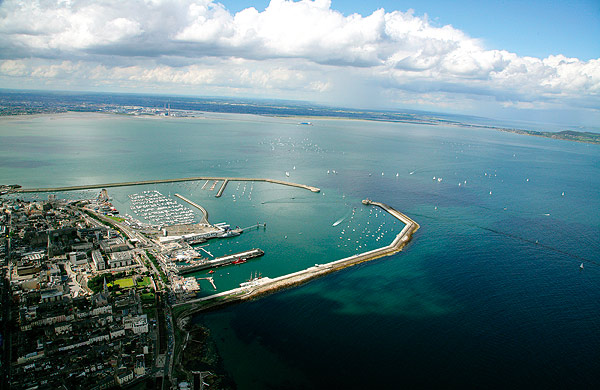
Dun Laoghaire Port on Dublin Bay
A Republic should be an entity in which there is open debate about public policy, not decision-making by elites. Flogging off our best assets, which is what this move by the Government is about, will not solve the nation’s problems. It is shocking to think that money from the sale of our vital transport arteries, the ports, could go to benefit those property speculators and banks which have bankrupted this nation.
This article is reprinted by permission of the CORK EVENING ECHO in which Tom MacSweeney writes maritime columns twice weekly. Evening Echo website: www.eecho.ie






























